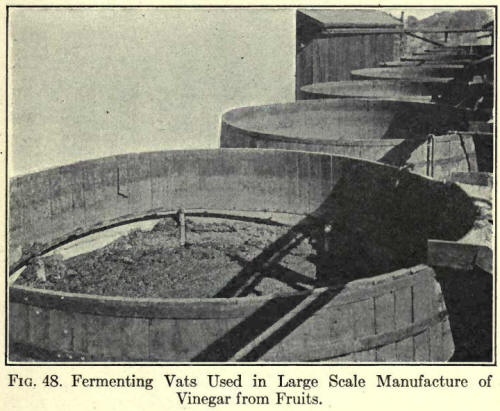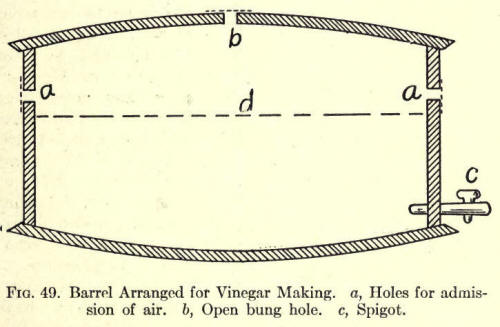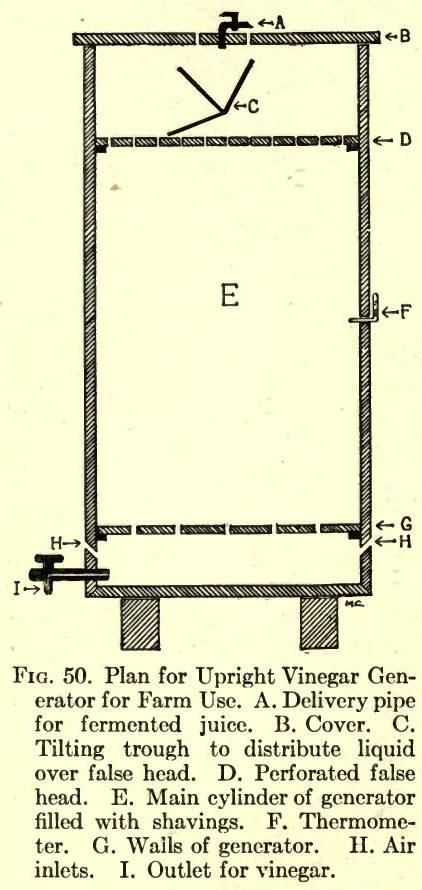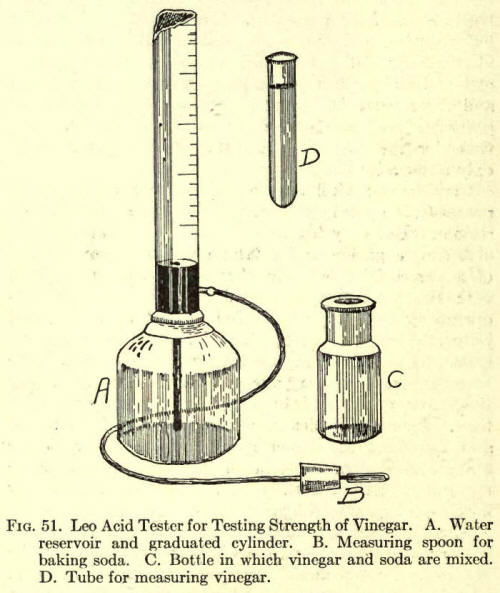|
Waste fruits, inferior
honey, and other sugar containing materials not suitable for sale or use
otherwise can often be made into satisfactory vinegar. The waste cores
and peels from canneries and fruit driers can be turned to profit, in
this way. Vinegar is used in enormous quantities for ketchup and pickles
in addition to the large amounts used as table vinegar.
Vinegar making is a
fairly simple process, provided the fundamental principles involved are
well understood.
79. General Principles.
Vinegar making depends on two fermentation processes. The first is a
transformation of sugar into alcohol, and carbonic acid gas by yeast.
The second is the conversion of the alcohol into acetic (" vinegar ")
acid. The second fermentation cannot take place before the first and
must follow the first. If it should start before the yeast fermentation
is complete, it will stop the yeast fermentation and give an inferior
vinegar. Vinegar manufacture depends on making these two fermentations
as efficient as possible, and in keeping them separate. In the following
paragraphs the methods of controlling the two fermentations are
discussed.
80. Raw Materials.
Any substance containing 10% or more sugar, or a substance easily
changed to sugar, or any fermented liquid containing 4% or more alcohol
can be made into vinegar in the household. Industrially starch and
distilled alcohol are also used. Fruit juices, dried fruits, fruit-sirups,
partially fermented jelly, honey, and spoiled wine can all be used.
Watermelons do not contain enough sugar.
81. Crushing Fruits
for Vinegar. Fruits used for vinegar should be thoroughly crushed in
a food chopper or fruit crusher. The crushed fruit should be placed in a
crock or wooden barrel, for yeast fermentation, before pressing. Grapes
and berries in small lots are easily

crushed by the hands. Very ripe peaches,
pears, apricots, and plums, are easily crushed with the hands or with a
potato masher. Apples require the use of a crusher or grinder. Yeast
should be added to the crushed fruit. See paragraph 84 on addition of
yeast. 82.
Diluting Honey. To each cup of honey add four cups of water and
one-half a cup of any fruit juice. Honey does not ordinarily contain
enough yeast food to cause a good fermentation. The fruit juice
furnishes this necessary food. Yeast must be added as directed in
paragraph 84.
83. Preparation of
Fruit Cores and Peels and Dried Fruits for Vinegar Making. Cores and
peels, give good results if two cups of water is added to each cup of
fruit, the mixture boiled until the fruit is tender, pressed and
sweetened with one half a cup of sugar to each four cups of juice. Dried
fruits contain about 60% of sugar. They may be used for vinegar making
if four pints of water is added to each pound of fruit. The mixture is
allowed to soak twenty-four hours. It is then heated to boiling and
allowed to cool. The fruit may then be pressed and the resulting juice
used for vinegar. Yeast should be added in the way described in
paragraph 84.
84. Addition of Yeast and Control of Alcoholic Fermentation. The
crushed fruit, diluted honey, and fruit juice prepared as described in
paragraphs 81, 82, and 83 must be allowed to pass through an alcoholic
fermentation. This is caused by yeast. Time materials contain yeast that
will cause fermentation, but usually the fermentation will be very poor
and an inferior product will usually result because the yeasts naturally
present are not of the proper varieties. Therefore, good yeast should be
added. All
containers and other utensils coming in contact with the juices or
fruits must be clean. Never under any circumstances add vinegar or
vinegar mother to fresh juices before fermentation. They should only be
added after yeast fermentation is complete.
If large amounts of vinegar are to be made,
suitable yeast may be obtained from the College of Agriculture,
University of California, Berkeley, California. This will be sent for
one dollar, prepaid, with directions for use. It is more satisfactory
than bread yeast.
To crushed fruit, compressed yeast is added at the rate of one cake per
three gallons of crushed fruit. The yeast must be broken up thoroughly
in the juice or crushed fruit. This can be done by mixing the yeast with
a little juice or water and then stirring the yeasty liquid in with the
crushed fruit.
Fruit juices and diluted honey are allowed to ferment until there is no
longer any gas given off and until all taste of sugar disappears. This
will be in about three weeks at room temperature.
Crushed fruits should be allowed to ferment
about a week. This will soften them so that the juice may be pressed out
easily. During fermentation, the crushed fruit should be stirred
frequently and should be screened or covered with a cloth to keep out
vinegar flies. The fruits are then pressed and the juice allowed to
ferment until all the sugar is destroyed. Yeast fermentation proceeds
most rapidly at warm temperatures. A temperature of about 800 to 900 F.
is the most favorable. At temperatures above 105° F., fermentation
ceases and at temperatures below 60° F., it proceeds extremely slowly.
At 83° to 90° F. fermentation will usually be complete in two weeks or
less. Because a warm temperature is so favorable, the stoneware crock or
other container should be kept in a warm room, except in hot summer
weather. Vinegar
flies often gather around fermenting fruits or juices. Their presence is
objectionable, both because of their appearance, and the fact that they
may infect the material with vinegar bacteria. Vinegar bacteria form
vinegar acid which seriously interferes with and may stop yeast
fermentation. It is essential that yeast fermentation run to completion
in order that a strong vinegar shall be formed. The flies may be kept
out of barrels or jars by the use of cheesecloth covers.
85. Pressing Fermented Fruits. The
same equipment can be used as described under paragraph 29, "The
Pressing of Fruits for Fruit Juice." If only a small amount (less than
five gallons) of crushed fruit has been fermented, it may be pressed
through a cheesecloth. Usually a great deal of the juice may be poured
off after fermentation is complete; this is especially true of soft
fruits. The pressed
juice should be placed in clean containers. Alcoholic fermentation will
continue for several days after pressing.
86. Removal of Sediment. When
alcoholic fermentation is over, the yeast and coarse fruit, pulp, etc.,
will settle out. When this has occurred the fermented liquid should be
drawn or poured off the sediment, because this material will affect the
flavor of the vinegar. Usually settling will have taken place in a month
after the start of alcoholic fermentation or within two weeks after
alcoholic fermentation is over. A hose is used to syphon off settled
fermented liquids from barrels; the liquid may simply be poured from a
crock or jar into another similar clean container.
87. Adding Vinegar Starter. When the
alcoholic fermentation is complete (but not before) the vinegar
fermentation should be started by the addition of a small amount of
vinegar. Never add vinegar until yeast fermentation is complete. This is
when gas is no longer given off and there is no longer a taste of sugar.
This may be (lone by adding one pint of barrel vinegar or new vinegar
from a grocery store to each gallon of fermented liquid after drawing it
off from the yeast sediment. To fermented orange juice add one quart of
vinegar per gallon. If there is any vinegar on hand from previous home
made lots, it may be used. The addition of several pieces of "vinegar
mother" also greatly assists the start of vinegar fermentation.
The vinegar adds millions of vinegar
bacteria which multiply rapidly in the alcoholic liquid and it also
increases the vinegar or acetic acid so that molding and growth of "wine
flowers" cannot take place. Mold and wine flowers often spoil alcoholic
liquids to be used for vinegar unless vinegar is added.
88. Vinegar Fermentation. Vinegar
fermentation must not be allowed to start until after alcoholic
fermentation is complete. Starting the vinegar fermentation is described
in the preceding paragraph.

The mixed vinegar and alcoholic liquid must
he so placed that a large surface is exposed to the air. If the liquid
is in a bottle the bottle should be filled only two- thirds full and
must not be corked. A cloth only should be placed over the mouth of the
bottle to keep out insects. A stoneware crock or glass fruit jar can be
used. It should be covered with a cloth only. If a barrel is used, leave
the bung open and fill the barrel only two- thirds or three-fourths
full. The arrangement in Fig. 49 is very good.
Vinegar fermentation proceeds must rapidly
in a warm room at 75° to 90°.F. At this temperature, vinegar will
usually form in about three or four months. It will then be ready for
filtration and use.

During the vinegar fermentation the liquid
should be Protected from vinegar diseases and pests as described in
paragraph 84.
89. Vinegar Generators. The rate of vinegar fermentation depends on
the amount of surface exposed to the air and to the temperature. Vinegar
generators enormously increase the surface and hence speed up the rate
of fermentation accordingly.
The most common type of generator is a
wooden cylinder 8 to 12 feet high and about 30 to 40 inches wide. This
is usually filled with beechwood shavings. Corn cobs, or rattan shavings
may also be used. Charcoal or coke in large pieces may be used for
distilled alcoholic liquids, but not for fruit juices because the
material would soon become clogged with sediment.
The acidified fermented juice is run through
the above generator slowly (not more than twenty-five gallons per day).
It is distributed over the perforated head of the generator by a tilting
trough and trickles down over the shavings. Air is admitted through air
holes near the bottom of the generator. Heat is generated by the
fermentation and the temperature in the generator is maintained at 80°
to 85° F. by regulating the rate of flow of liquid and air supply. A
mixture of one part vinegar and three parts fermented liquid enters the
top of the generator and vinegar issues from the bottom. The time for
the liquid to flow through the generator is only a few minutes.
Considerable skill and experience are
necessary to successfully operate vinegar generators and their use is
recommended only for relatively large installations.
A simple generator for farm use can be
constructed of a barrel filled with beechwood shavings and fitted with
two wooden spigots and hole at each end. To operate this generator, it
is filled half full with fermented juice acidified with one gallon of
vinegar to each three gallons of liquid. The upper spigot is left open.
The barrel is turned halfway over several times daily, closing the lower
spigot and opening the upper spigot each time. Air enters holes in
centers of ends of the barrel and flows out the upper spigot furnishing
air to the liquid and vinegar bacteria on the wet shavings in the upper
part of the barrel. A form of revolving generator is also used
commercially. The
operation and construction of vinegar generators is very well described
in a circular published by the Hydraulic Press Manufacturing Company of
Mt. Gilead, Ohio. This company will send the above circular free on
request.

Vinegar fermentation should be watched
carefully and when the vinegar is strong enough for use it should be
placed in completely filled containers such as barrels or bottles. Where
very large amounts of vinegar are made, the vinegar should be analyzed
for acid content. The instrument shown in Fig. 51 is used by vinegar
factories. Directions for its use accompany it. It can be used by
anyone. 90.
Aging of Vinegar. Vinegar is greatly improved in flavor by storing
for one year in well-filled closed wooden barrels. It does not age very
well in well-filled bottles and may deteriorate in open barrels and
tanks after reaching its maximum strength. The bacteria form acid so
long as any alcohol is left. When all of the alcohol is changed to acid,
they attack the acid itself if the vinegar is exposed to air and may
completely destroy all the acid or seriously lower the quality of the
product. Hence the necessity for storing it in well-filled closed
containers when the maximum acid content is reached. This point is
determined by analysis with instruments shown in Fig. 51 if a large
quantity of vinegar is made. In the household the taste will serve as a
guide. 91.
Clearing the Vinegar. If the vinegar is for home use it may be made
sufficiently clear by straining through heavy cloth.
If it is to be sold, it may be necessary to
clarify it by the methods outlined in Recipe 95. However, vinegar made
in small quantities usually becomes clear after settling several months
and only the sediment need be filtered or strained.
92. Vinegar Diseases and Pests.
(a) Wine Flowers. This disease is caused by
a film yeast growing on freshly fermented fruit juices and is seen as a
white powdery or wrinkled and easily broken film. It is easily
distinguished from vinegar mother because vinegar mother is thick,
slimy, almost colorless, and tough. Wine flowers destroy the alcohol of
the liquid and (10 not form any acid. They are especially dangerous in
fermented orange juice or other fermented juices of low alcohol content.
If vinegar at the rate of one or two pints to every gallon of fermented
liquid is added when yeast fermentation is complete, there will be
little danger of injury by wine flowers. Pure yeast added to the fresh
juice before fermentation, also reduces the possibility of growth of
wine flowers. (b)
Lactic Acid Bacteria. These grow in fermented liquids producing
disagreeable flavors and cloudiness. They can be controlled as directed
for wine flowers.
(c) Vinegar Eels. These are small nematode worms just large enough to be
seen in the vinegar when it is held to the light in a small glass tube
or small tumbler. They are not especially harmful to health but their
appearance is not pleasing. They may infest generators so badly that the
generators cannot be used until the eels have been killed.
They may be killed by heating the vinegar to
120º F. in an agateware pot or by heating in some other way. Generators
infested with eels are sterilized by live steam. Tanks in which infested
vinegar has been stored should he steamed or sulphur should be burned in
them several times so that the fumes will kill the eels. They can also
be removed by close filtration. Eels will seldom appear in very small
lots of vinegar, but are very common in vinegar factories where they
usually do not become numerous enough to require repressive measures. |

